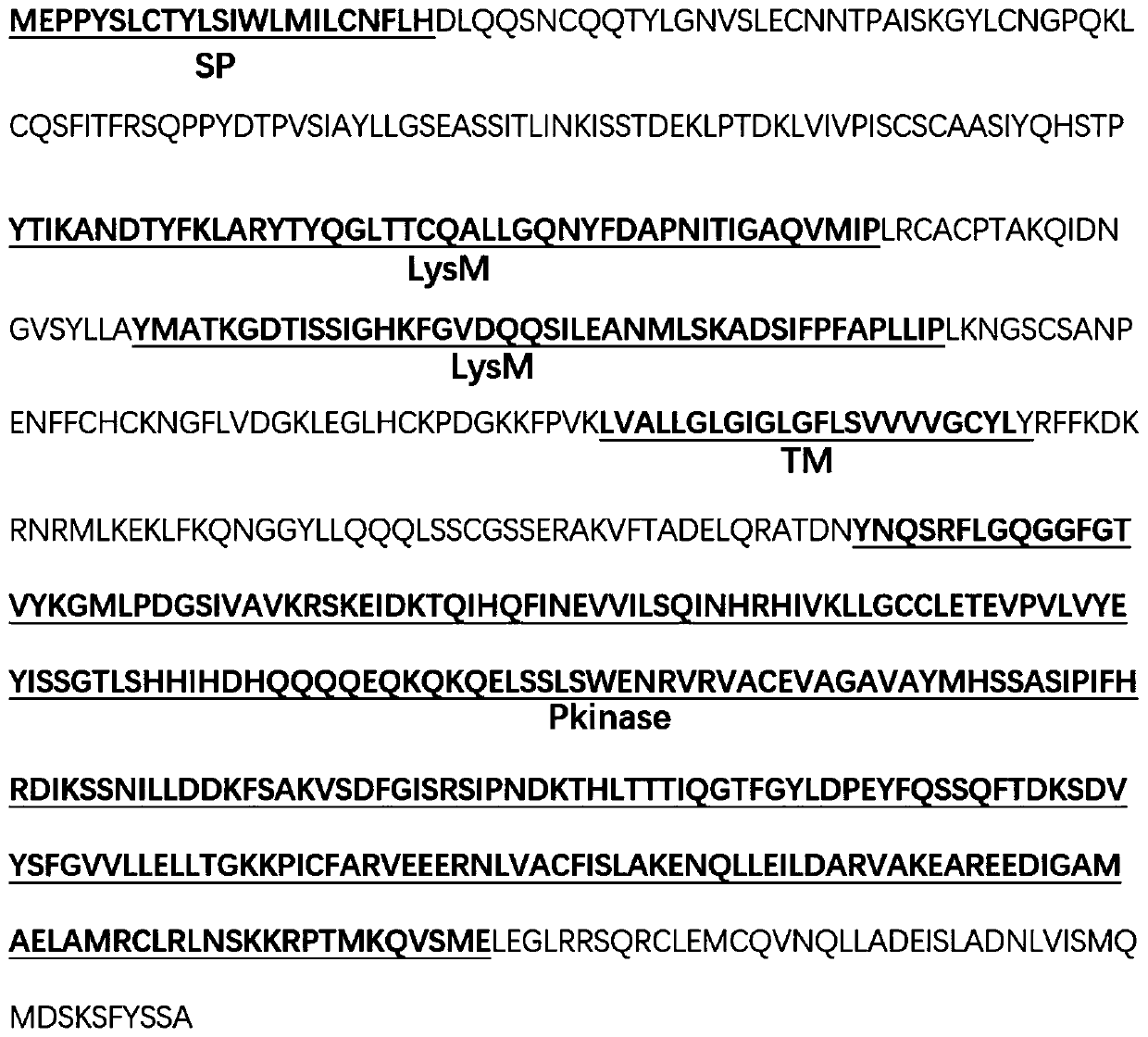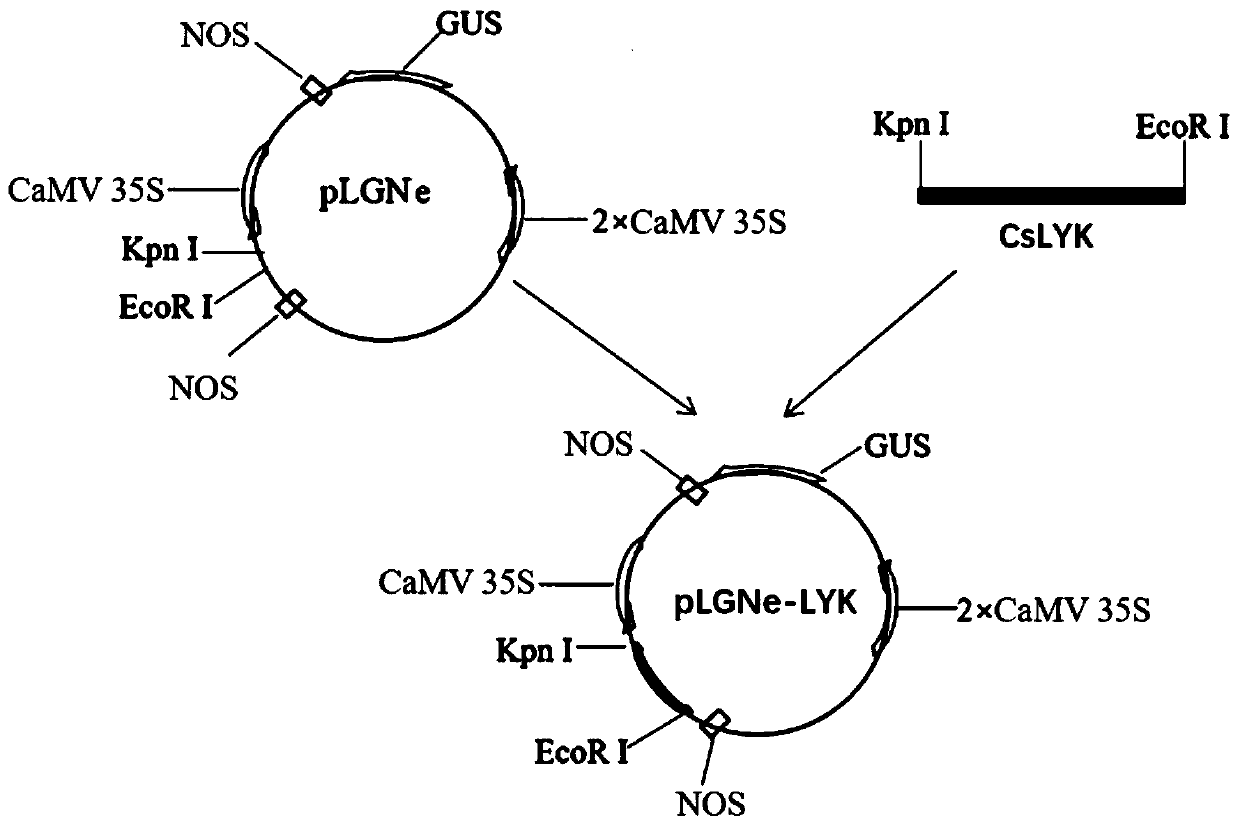Application of CsLYK gene and encoded protein thereof in improving resistance to citrus canker
A citrus canker and protein-encoding technology is applied to the CsLYK gene and its encoded protein to improve the application field of citrus canker resistance, and achieve the effects of reducing the degree of disease, reducing the area of lesions, and having great application value.
- Summary
- Abstract
- Description
- Claims
- Application Information
AI Technical Summary
Problems solved by technology
Method used
Image
Examples
Embodiment 1
[0043] Cloning of Citrus CsLYK Gene Coding Sequence
[0044] 1. RNA extraction and cDNA synthesis
[0045] Total RNA was extracted from citrus (Wanjincheng) leaves with an RNA extraction kit (Adelaide, CAT: RN09). The RNA quality was verified by agarose gel electrophoresis, and its concentration was measured with a densitometer. Recombinant DNase I was used to synthesize cDNA (TAKARA), and the cDNA was stored at -20°C for future use.
[0046] 2. PCR amplification of CsLYK gene coding sequence
[0047] Use primer OE-F (SEQ ID No.3) and OE-R (SEQ ID No.4) to obtain CsLYK fragment ( figure 1 ), the length of the fragment is 2054bp (including the enzyme cutting site), the amplified DNA fragment is sequenced and analyzed as the coding sequence of the citrus CsLYK gene, and the software analyzes the corresponding amino acid sequence and structural domain to verify the correctness of the protein. It has two LysM domain, a kinase domain, a signal peptide, and a transmembrane domain...
Embodiment 2
[0053] Construction of overexpression vector and transformation of Agrobacterium
[0054] The vector construction flow chart is as follows image 3 , all restriction endonucleases were purchased from (THERMO) company, and operated according to the instruction.
[0055] The specific operation is as follows: the CsLYK gene fragment and the overexpression vector pLGNe were double-digested with restriction endonucleases EcoRI and KpnI, recovered and ligated overnight, using T4 DNA Ligase kit (TAKARA) for ligation. The ligation product was transformed into Escherichia coli DH5α, and the plasmid was extracted from the positive clone to obtain the overexpression vector pLGNe-LYK of CsLYK. Plasmid extraction kits (Adelaide) were used.
[0056] The constructed overexpression vector was introduced into Agrobacterium tumefaciens EHA105 by electric shock method. Take the frozen EHA105 Agrobacterium competent cells (50 μL) in advance, thaw on ice, add 2 μL of the constructed overexpress...
Embodiment 3
[0058] Genetically Transformed Citrus (Wanjincheng)
[0059] 1. Acquisition of epicotyls from citrus seedlings
[0060] Fresh citrus (Wan Jincheng) fruit is washed, 70% alcohol surface disinfection, the seeds are taken out under aseptic conditions, the seed coat is peeled off, germinated on the seed germination medium, cultivated in the dark at 28°C for 2 weeks, and then in 16h light / Incubate for 1 week under 8h dark conditions. Under sterile conditions, the epicotyls of germinated seedlings were cut into 1 cm stem segments for genetic transformation of Agrobacterium tumefaciens.
[0061] 2. Preparation of Agrobacterium tumefaciens
[0062] The Agrobacterium bacteria solution (containing the CsLYK overexpression vector) used for transfection was added with 30% sterile glycerol and stored in an ultra-low temperature incubator at -80°C. Before transfection, streak culture on LB solid medium containing 50 mg / L kanamycin. Pick a single colony, inoculate in 25ml LB liquid medi...
PUM
 Login to View More
Login to View More Abstract
Description
Claims
Application Information
 Login to View More
Login to View More - R&D
- Intellectual Property
- Life Sciences
- Materials
- Tech Scout
- Unparalleled Data Quality
- Higher Quality Content
- 60% Fewer Hallucinations
Browse by: Latest US Patents, China's latest patents, Technical Efficacy Thesaurus, Application Domain, Technology Topic, Popular Technical Reports.
© 2025 PatSnap. All rights reserved.Legal|Privacy policy|Modern Slavery Act Transparency Statement|Sitemap|About US| Contact US: help@patsnap.com



